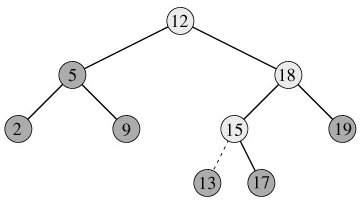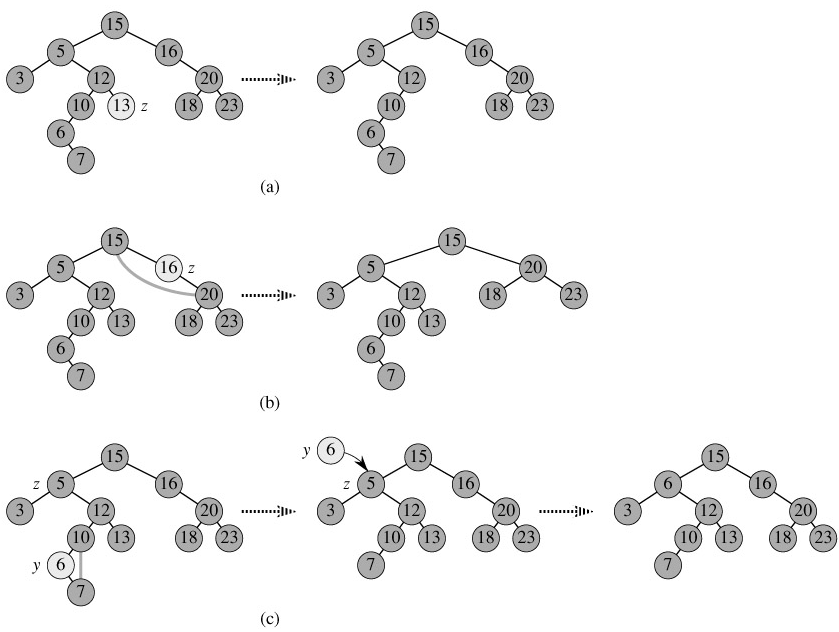Insertion And Deletion
Insertion and deletion: The operations of insertion and deletion cause the dynamic set represented by a binary search tree to change. The data structure must be modified to reflect this change, but in such a way that the binary-search-tree property continues to hold. As we shall see, modifying the tree to insert a new element is relatively straight-forward, but handling deletion is somewhat more intricate.
Insertion
To insert a new value v into a binary search tree T , we use the procedure TREE-INSERT. The procedure is passed a node z for which key[z] = v, left[z] = NIL, and right[z] = NIL. It modifies T and some of the fields of z in such a way that z is inserted into an appropriate position in the tree.
TREE-INSERT(T, z) 1 y ← NIL 2 x ← root[T] 3 while x ≠ NIL 4 do y ← x 5 if key[z] < key[x] 6 then x ← left[x] 7 else x ← right[x] 8 p[z] ← y 9 if y = NIL 10 then root[T] ← z ⊹ Tree T was empty 11 else if key[z] < key[y] 12 then left[y] ← z 13 else right[y] ← z
Figure 12.3 shows how TREE-INSERT works. Just like the procedures TREE-SEARCH and ITERATIVE-TREE-SEARCH, TREE-INSERT begins at the root of the tree and traces a path downward. The pointer x traces the path, and the pointer y is maintained as the parent of x. After initialization, the while loop in lines 3-7 causes these two pointers to move down the tree, going left or right depending on the comparison of key[z] with key[x], until x is set to NIL. This NIL occupies the position where we wish to place the input item z. Lines 8-13 set the pointers that cause z to be inserted.

Like the other primitive operations on search trees, the procedure TREE-INSERT runs in O(h) time on a tree of height h.
Deletion: The procedure for deleting a given node z from a binary search tree takes as an argument a pointer to z. The procedure considers the three cases shown in Figure 12.4. If z has no children, we modify its parent p[z] to replace z with NIL as its child. If the node has only a single child, we "splice out" z by making a new link between its child and its parent. Finally, if the node has two children, we splice out z's successor y, which has no left child and replace z's key and satellite data with y's key and satellite data.

The code for TREE-DELETE organizes these three cases a little differently.
TREE-DELETE(T, z) 1 if left[z] = NIL or right[z] = NIL 2 then y ← z 3 else y ← TREE-SUCCESSOR(z) 4 if left[y] ≠ NIL 5 then x ← left[y] 6 else x ← right[y] 7 if x ≠ NIL 8 then p[x] ← p[y] 9 if p[y] = NIL 10 then root[T] ← x 11 else if y = left[p[y]] 12 then left[p[y]] ← x 13 else right[p[y]] ← x 14 if y ≠ z 15 then key[z] ← key[y] 16 copy y's satellite data into z 17 return y
In lines 1-3, the algorithm determines a node y to splice out. The node y is either the input node z (if z has at most 1 child) or the successor of z (if z has two children). Then, in lines 4-6, x is set to the non-NIL child of y, or to NIL if y has no children. The node y is spliced out in lines 7-13 by modifying pointers in p[y] and x. Splicing out y is somewhat complicated by the need for proper handling of the boundary conditions, which occur when x = NIL or when y is the root. Finally, in lines 14-16, if the successor of z was the node spliced out, y's key and satellite data are moved to z, overwriting the previous key and satellite data. The node y is returned in line 17 so that the calling procedure can recycle it via the free list. The procedure runs in O(h) time on a tree of height h.